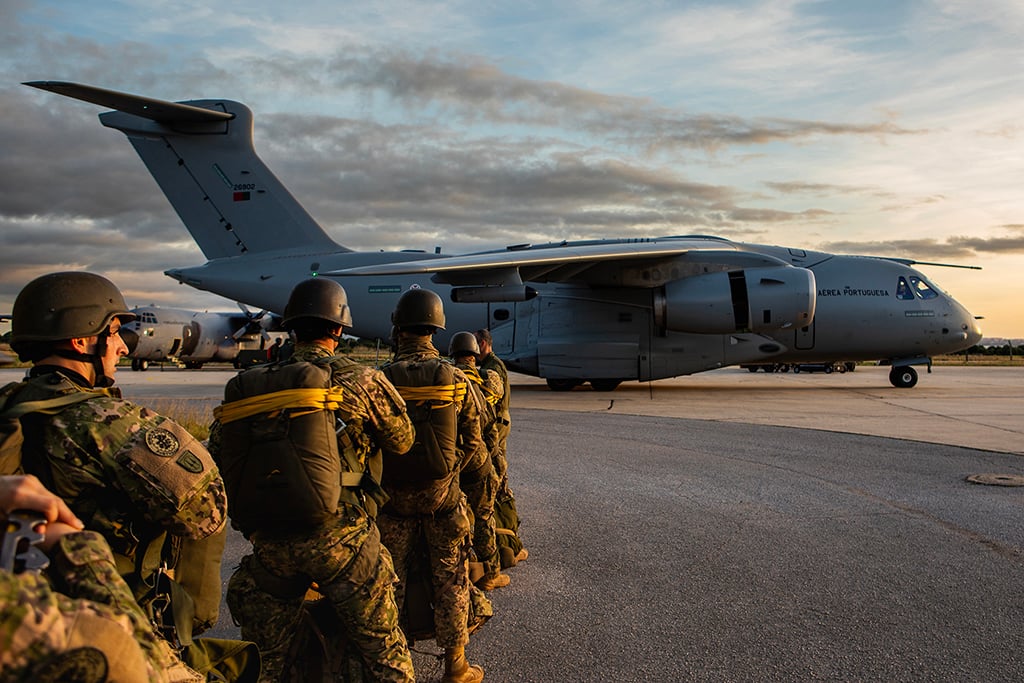This article is published in Aviation Week & Space Technology and is free to read until May 09, 2025. If you want to read more articles from this publication, please click the link to subscribe.

Portugal has flown about 10% of the global KC-390 fleet flight hours with just two aircraft and demonstrated airdropping of supplies and paratroopers with the platform.
Portugal’s air force is gearing up to widen the role of its new Embraer KC-390 fleet from aero logistics to air-to-air refueling and aerial firefighting.
In less than two years, the service has thrown the twin-jet airlifter into front-line use, with its fleet of just two KC-390s conducting about 10% of global KC-390 flying hours, transporting equipment in support of United Nations (UN) missions in Africa and NATO missions in Eastern Europe, as well as Sikorsky UH-60 Black Hawk helicopters from the U.S.
- Lisbon has two in service; a third is to arrive soon
- Speed, payload and range drove the air force’s choice
Embraer is hoping the Portuguese experience can smooth the introduction of the airlifter elsewhere—and sway other countries to buy the aircraft. In the U.S., the manufacturer is actively marketing the C-390 as an “Agile Tanker” to supplement larger platforms such as Boeing’s KC-46 or KC-135.
As one of Europe’s smaller air forces—but one with significant responsibilities to the Azores and Madeira archipelagos as well as links with its former African territories—Portugal’s decision to acquire a new airlifter to replace Lockheed Martin’s workhorse C-130 Hercules was not taken lightly.
“When we announced we would acquire the KC-390, several countries said to us, ‘Are you sure? Are you crazy?’” Brig. Gen. Joao Rui Ramos Nogueira, chief of the Portuguese Air Force’s Engineering and Programs Directorate, told journalists during a media tour arranged by Embraer in March. Nogueira noted that his counterparts in other countries had questioned whether the Brazilian OEM, with its tradition of producing commercial and business aircraft, could develop a combat-ready, robust airlifter that could compete with the C-130.
He said the service had been impressed by Embraer’s concepts, including how it brought commercial aviation experience to the platform’s design, which “gave us the confidence that their aircraft could be the one,” he said.

Portugal finally ordered the KC-390 in 2019, six years after joining the C-390 program. The first aircraft was delivered in October 2023, and a second the following June, while the third will appear in the coming weeks and the final pair in 2027. Lisbon has an option for a sixth and must make a decision on the matter this year. Once the five aircraft are in service, Portugal can phase out its 50-year-old C-130H fleet.
The moment the aircraft began flying missions, Nogueira said, “We started receiving letters from countries, saying, ‘Can we talk to you about the KC-390?’”
He added that Portugal’s choice has since been vindicated by orders from other European countries, most notably Austria, the Czech Republic and the Netherlands. Slovakia and Sweden have selected the platform but have not yet signed contracts.
Aside from the political ambitions of Portugal’s fledging aerospace industry, which has supported the KC-390’s development, the platform’s speed, range and payload characteristics were at the heart of the selection decision.
Flying Portuguese peacekeepers to support the UN’s Multidimensional Integrated Stabilization Mission in the Central African Republic (CAR) can often be complicated by a lack of diplomatic clearances from North and West African nations, which forces the flights to travel via Cape Verde to Ghana and then to the CAR. This can take a C-130 six days, while the KC-390 can do it in just three, officials say. They add that for airlift missions to support a deployment of F-16s, carrying a mix of pallets and passengers requires two C-130 sorties but only a single one by a KC-390. Although the KC-390 has a payload capacity of around 26 metric tons, the average load for the Portuguese Air Force is around 14.
“The difference between the C-130 and the KC-390 is so big, you cannot help but be impressed,” said Maj. Miguel Pousa, squadron commander of the Portuguese Air Force’s KC-390 unit, Esquadra 506, also known as the Rhinoceroses.
Within days of receiving their first KC-390, Esquadra 506 had deployed the aircraft to the U.S. to collect refurbished Black Hawk helicopters for the air force’s firefighting mission. They have delivered three this way, and a fourth will follow shortly. The KC-390’s hold can swallow the Black Hawk whole, albeit only with its rotor hub and main and tail rotor blades removed.
More recently, one KC-390 deployed to Ramstein Air Base in Germany, where the U.S. Army loaded it with a 16-metric-ton High-Mobility Artillery Rocket System (Himars). Pousa said the Army personnel were impressed by the speed at which the vehicle could be loaded and unloaded without modification and that a magazine reload for the system could be fitted onto the loading ramp.
U.S. forces have been regularly practicing flying into remote airfields and firing missiles from Himars before reloading the system and flying away as part of the NATO Agile Combat Employment initiative. This effort had previously relied on Boeing C-17s, but as the KC-390 fleet grows, the options for deploying Himars this way are growing.
The Portuguese Air Force has built entirely new facilities for Esquadra 506 at Beja Air Base, including a maintenance hangar, spares warehouses and squadron offices, as well as a training facility housing a Rheinmetall full flight simulator that was being commissioned during Aviation Week’s visit. The purchase of the flight simulator is part of a wider plan to sell hours to other air forces to support their training, as the only other KC-390 simulator available is in Brazil.
Portuguese Defense Minister Nuno Melo, who visited Beja the next day, declared that the country would acquire a second flight simulator to help secure Portugal’s role in training KC-390 pilots. “There are several countries interested in the KC-390, and the training of these pilots will take place here in Beja,” Melo said. “This is a decisive step.”
Once the first flight simulator is commissioned and the third aircraft arrives, Pousa expects the squadron to be able to declare an enhanced initial operational capability (IOC+), giving it bandwidth to prepare for other planned missions including aerial refueling. This capability will not be focused on Portugal, Pousa said, but more broadly for NATO and Europe, helping to address regional shortfalls in tanker fleets—particularly for helicopter aerial refueling, which the KC-390 can perform thanks to its low-speed capabilities.
Portugal will invest in giving the KC-390s an aerial firefighting role, too, following recent devastating wildfires in the country. This will include adopting the Modular Airborne Fire Fighting System (MAFFS II), which the Brazilian Air Force already uses. The Portuguese Air Force will also build tactical capabilities with the aircraft, with landings on rough, unpaved strips planned for later this year.
Pousa’s crews have been performing flights to short, paved runways, including in Flores, the westernmost island on the Azores, which has a 4,000-ft. runway with challenging Atlantic crosswinds.
Acquisition of the KC-390 forms part of the Portuguese Air Force’s Vision 5.3. The service is aiming to ready itself for fifth-generation combat aircraft while boosting personnel, processes and technology to support them. While transatlantic geopolitics have thrown plans for a fifth-generation fighter into the air (AW&ST March 24-April 6) and prompted Lisbon to discount a potential procurement of the Lockheed Martin F-35 Joint Strike Fighter, Nogueira says the KC-390 “fully aligns” with the concept because of the options it brings for future capability. “The KC-390 opens a lot of fronts for us,” he said.





